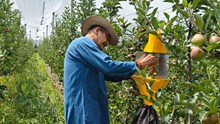
On World Environment Day, conversations often focus on large-scale policy changes and global sustainability goals. Yet true environmental transformation often begins at the grassroots, with individuals who dare to challenge the status quo. One such example is Haricharan Oraon, a farmer from Dhurleta village in Ranchi, Jharkhand, whose inspiring journey from hardship to success shows that sustainable farming is not just a necessity, but a quiet revolution taking root in rural India.
A Battle Against Poverty and Uncertainty
Haricharan grew up in Dhurleta village in Ranchi district, where the land was fertile but opportunities were limited. Due to his family's financial struggles, he had to drop out of school after the eighth grade. Even basic needs like food, clothing, and education were hard to afford. To survive, Haricharan and his father would often forage for wild tubers like getthi and peetiya in the nearby forest.
Determined to change his circumstances, he migrated to Punjab and worked as a farm labourer for over a decade. Though he earned a living, the distance from home took a toll on him. When he eventually returned to his village, he made a bold decision, to reclaim his land and start anew. He realised that farming came with its own set of challenges such as limited resources, outdated techniques, and no financial safety net. But what Haricharan did have was a deep resolve to change his future.
Sowing the Seeds of Sustainability
Haricharan’s turning point came when he was introduced to climate-smart agriculture through Transform Rural India’s Millionaire Farmer Development Programme (MFDP), Transform Rural India (TRI) being a development design organisation that works on transforming India's bottom 100,000 languishing localities into flourishing communities. He realized that farming wasn’t just about growing crops—it was about working with nature, not against it.
His personal experience taught him that farming in forested regions came with unique challenges, such as crop damage from wild animals like monkeys and the risk of excessive rainfall. One of the most important insights he gained was understanding how the overuse of chemical fertilizers and pesticides harms soil organisms, much like how excessive antibiotics can affect the human body.
Through TRI, Haricharan was introduced to protected farming techniques and received consistent guidance. With scientific training and a shift in mindset, he replaced conventional chemical-heavy practices with sustainable methods, including:
-
Drip irrigation to optimize water usage
-
Organic inputs to naturally restore soil health
-
Protected cultivation to shield crops from erratic weather and pests
-
Multi-tier cropping to maximize land efficiency
His first experiment, growing cucumbers in a net house protected from monkeys and other wild animals, was a success, earning him over Rs 40,000 from just 10 decimals of land, a significant achievement.
Encouraged by this, Haricharan reinvested his earnings to set up a second net house and expanded his cultivation. He began growing capsicum, cauliflower, exotic and leafy vegetables, grafted tomatoes, and seasonal crops using the protected farming model. In his open fields, he also cultivated tomatoes, cabbage, French beans, garden peas, and creeper crops like bottle gourd and chilli using drip irrigation.
Inspired by his training, he adopted a multi-tier farming model, integrating mango orchards with ginger, papaya, and seasonal vegetables. His move to organic farming also brought additional income through the sale of organic products to nearby farmers.
With continued support and training, Haricharan fully embraced modern and organic methods, gradually increasing his annual income from Rs 2.65 lakh to Rs 10.75 lakh over four years, farming just five acres of land. His annual farming expenses were also kept within Rs 3–4 lakh, thanks to his reliance on eco-friendly practices.
Beyond His Own Land: A Village Transformed
Haricharan’s success wasn’t just his own—it sparked a major shift among farmers in his village toward organic and scientific farming practices. Instead of keeping his knowledge to himself, he began training fellow farmers, helping them move from subsistence farming to sustainable agriculture.
Through community-driven efforts, the villagers built ponds, wells, and irrigation systems to secure water resources and improve crop yields. With government support, drip irrigation networks were installed, ensuring long-term agricultural sustainability.
This collective transformation reflects the true goal of TRI, a rural renaissance. What was once a struggling community has become a thriving rural ecosystem. Today, Haricharan’s farm draws visits from neighbouring farmers and policymakers to witness the impact of nature-friendly scientific methods in agriculture. His journey proves that one farmer can spark lasting change, not just for himself, but for generations to come.
A Message for World Environment Day
Haricharan’s story captures the spirit of World Environment Day—that true progress begins with sustainable choices. By embracing eco-friendly farming, he has shown that smallholder farmers can reverse land degradation, achieve financial stability, and protect the environment all at once.
“After working hard in someone else’s fields, I realized the effort is the same. So why not work on your own land? When you love nature and the land, it gives back. Thanks to TRI for the scientific guidance and support," says Haricharan.
This Environment Day, let Haricharan’s story inspire those who dream of a greener future. It’s a reminder that sustainability starts at home—in our soil, in our communities. If one farmer with the right tools and mindset can lead change, so can we, by doing our part for nature.
















